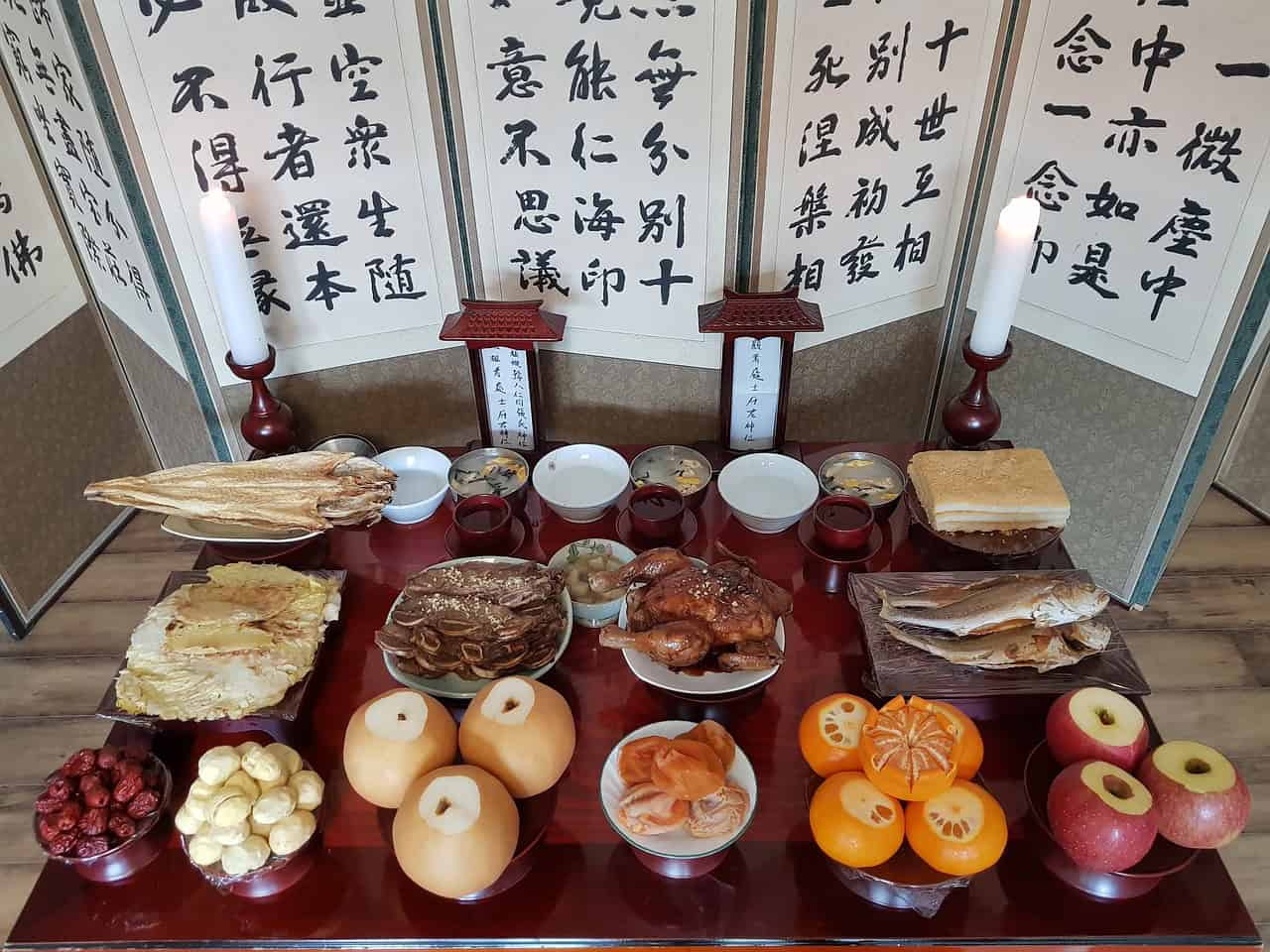Korean Thanksgiving, known as Chuseok or Hangawi, is one of Korea's most important holidays. Celebrated on the 15th day of the 8th month of the lunar calendar, Chuseok always falls in September or October (this year, Chuseok is on Monday, October 6th, 2025).
During this time, families gather to pay respect to their ancestors and enjoy traditional foods like songpyeon (rice cakes). The celebration marks the autumn harvest and is a time for gratitude and family reunions; people often visit their ancestral hometowns, leading to one of the biggest travel periods in the country.
Activities include folk games, dances, and preparing heaps of delicious food to share. For those curious about Korean culture, learning about Chuseok offers a glimpse into the heart of Korean family values and traditions, whether it's through the preparation of special dishes or the practice of honoring ancestors.

Jump to:
⌛ Historical Background
Origins of Chuseok
Chuseok traces its origins back to the Silla Dynasty, over 2,000 years ago. The festival was initially called Gabae and began as a weaving contest between 2 teams in Silla, which later evolved into a festival celebrating the harvest. This event marked the end of the agricultural season where people gave thanks for the year's harvest.
Chuseok and the Lunar Calendar
Chuseok is celebrated on the 15th day of the 8th month of the lunar calendar, said to be when the moon is at its fullest and brightest. The lunar calendar plays a significant role in Korean culture and many traditional holidays are based on it, which is why the dates of so many Korean holidays move each year.
This timing, with the full moon, symbolized a bountiful harvest and prosperity. The three-day holiday period includes the day of Chuseok and the days before and after, allowing families to travel and engage in various customs. In 2025, Chuseok falls from October 5-7.
Connections to Agrarian Society
Chuseok is often likened to a mid-autumn festival and has strong connections to Korea's agrarian society. Ancient agrarian customs included thanking the deities and ancestors for the bountiful harvest.
During Chuseok, families prepare and share foods made from the year's harvest, such as songpyeon (rice cakes filled with sesame seeds, beans, or chestnuts).
These special foods hold symbolic meaning and are used in ancestral rites known as Charye. This practice reflects the deep respect Koreans have for their ancestors and the importance of family bonds in their culture.

🎉 Cultural Significance
Ancestral Worship and Confucianism
An important aspect of Chuseok is the ritual of ancestral worship, known as Charye. Influenced by Confucianism, families honor their ancestors by preparing a feast and setting a table with foods such as rice cakes (songpyeon), freshly harvested vegetables, and fruits.
Families visit ancestral hometowns and ancestral graves to pay respects, a practice called Bulgwi - they clean the gravesites and offer food and drinks to honor their ancestors.
This ritual reinforces the importance of genealogy and familial heritage in Korean culture, in which it's believed that showing respect to ancestors brings blessings and prosperity to the family.
Family and Generational Bonds
Chuseok brings families together from far and wide, reinforcing generational bonds. It’s common for people to travel long distances to their hometowns to be with extended family, making it one of the busiest travel periods in Korea (you'll want to be going into Seoul rather than out of it, if you travel at all during this period!).
Family members enjoy traditional games, dances, and meal preparations, creating a festive environment. Children learn from their elders about family history and customs, solidifying their understanding and appreciation of their heritage. This focus on family strengthens intergenerational connections and ensures the continuation of cultural traditions.
Chuseok in Modern Times
While traditional practices remain important, Chuseok celebrations have evolved to incorporate modern elements. Many families now include contemporary dishes in their holiday feasts and engage in new activities during the holiday period.
City residents may celebrate with local events, parades, and festivals, making Chuseok more accessible to those unable to travel. Media and entertainment also play a big role, with special television programs and online content highlighting Chuseok’s significance.
This blend of old and new helps keep the holiday relevant for younger generations while preserving its cultural essence.
🎊 Traditional Festivities
Rituals and Ancestral Rites (Charye)
During Chuseok, families perform Charye, a respected ancestral rite; they set up a table with foods like rice cakes, fruits, meat, and japchae. This offering expresses gratitude to ancestors for the year's harvest.
Seongmyo is another important tradition in which families visit ancestral graves to clean and straighten them, a practice known as beolcho. They pay respects and give thanks; this connection with their pastis thought to strengthen family bonds and cultural identity.
Folk Games and Entertainment
Chuseok also includes vibrant folk games and performances. Ganggangsullae, a traditional circle dance, is popular, especially among women - participants hold hands, singing and dancing under the full moon, a dance symbolizing unity and community spirit.
Ssireum, or Korean wrestling, is another highlight. Competitors try to bring each other to the ground using skill and strength, a sport enjoyed by many and symbolizes the holiday's festive nature. Other activities include archery, weaving contests, and various musical performances, bringing communities together in celebration and joy.
The Significance of the Full Harvest Moon
The full harvest moon holds special significance during Chuseok. It's a time for families to gather and reflect on their blessings, and the moon is believed to bring prosperity and a bountiful harvest.
Traditional festivities often include moon-viewing gatherings. People sit outdoors, enjoying snacks and drinks while appreciating the beautiful moon, an event meant to foster a sense of peace and gratitude.
The moon's illumination during Chuseok also symbolizes hope and renewal, a magical element of the holiday that enhances its meaning and the shared experiences of the people celebrating it.

🎊 Culinary Traditions
Feast Preparation and Celebratory Foods
During Chuseok, families gather to prepare a grand feast that celebrates the harvest. The process includes making dishes from fresh ingredients like vegetables, beef, and fish.
Families often prepare assorted jeon, which are savory Korean pancakes made from ingredients like green onions, zucchini, and meat. Japchae, a popular noodle dish made with sweet potato noodles and mixed vegetables, is also commonly served.
Rice wine, or makgeolli, is another staple, enjoyed alongside the meal. The preparation of these dishes is an important family activity that symbolizes unity and gratitude.
Significance of Rice Cakes (Songpyeon)
Songpyeon, a type of rice cake, holds special significance during Chuseok. Made from glutinous rice flour, these half-moon shaped cakes are pine-scented and filled with ingredients such as sesame seeds, sweet red beans, or chestnuts.
The making of songpyeon is a family affair, often involving multiple generations. It’s believed that the person who makes the most beautiful songpyeon will have a beautiful daughter or son, depending on the gender of the maker.
These rice cakes are steamed over pine needles, which gives them a unique, fragrant flavor. Songpyeon symbolize the importance of the harvest and the hope for future prosperity.
Common Dishes and Delicacies
Chuseok's feast includes an array of dishes and delicacies such as galbijjim (braised short ribs) and toran guk (taro soup). These dishes often highlight the use of fresh seasonal ingredients like mushrooms, chestnuts, and freshly harvested rice.
Fruit, such as Korean pears and persimmons, is also abundant during the holiday. Koreans place importance on beautifully displaying these fruits as part of ancestral rites.
Gift sets are also common during Chuseok, often including items like high-quality meats, fruits, and traditional sweets. These gifts are typically exchanged between family members and friends to show appreciation and respect.
🎑 Contemporary Practices
Travel During Chuseok
Travel is a major part of Chuseok. Many Koreans travel from cities like Seoul to their hometowns. The holiday leads to crowded highways and public transport. Traffic jams are a common issue, with travel times often taking twice as long, if not longer.
Despite the congestion, this annual migration is a cherished tradition. People are eager to reunite with family and take part in ancestral rites and feasts together. Some also take the opportunity to travel abroad or visit local tourist attractions if they can't make it home.
Gift-Giving and Modern Influences
Gift-giving has become an important aspect of Chuseok. Traditional and modern gifts are exchanged, showing appreciation and goodwill; common gift sets include fruits, rice cakes, and beverages, but more unique items have also gained popularity.
One interesting gift trend during Chuseok in South Korea is giving Spam gift sets - it may be strange for Americans, but Spam is considered a luxurious item and is well-received by many. Korean supermarkets offer beautifully packaged Chuseok gift sets, including large pieces of fruit (generally pears), making shopping for the holiday more convenient.
Buddhist Koreans might give offerings at temples, blending religious practices with the season's spirit of thankfulness. These practices highlight how modern influences and traditional values coexist harmoniously during this festive time.

👘 Fashion and Attire
The Role of Hanbok during Chuseok
Hanbok, also called choson-ot in North Korea, is the traditional Korean dress worn during Chuseok and other important holidays. The outfit consists of vibrant colors and simple lines without pockets, designed to represent the beauty of the Korean culture.
Men typically wear a jacket (jeogori) and pants (baji). Women wear a longer jacket and a skirt (chima). Both genders might accessorize with ribbons or shoes specific to the hanbok.
Wearing hanbok during Chuseok connects modern Koreans with their ancient traditions, adding a festive touch to the Autumn Harvest celebrations. The hanbok is not just about fashion; it reflects the deep heritage and pride of the Korean people, making it an essential part of Korean Thanksgiving.
❓ Frequently Asked Questions
During Chuseok, Koreans often participate in ancestral rites called charye, rituals which honor deceased ancestors. People also visit their hometowns, spend time with family, and clean the graves of their ancestors in a tradition known as seongmyo. Folk games like ganggangsullae, a circle dance, are popular activities.
Some dishes commonly prepared for Chuseok include songpyeon, which are pine-scented rice cakes filled with sweet or semi-sweet ingredients, and jeon, which are types of pancakes made from various vegetables, fish, or meat. Another popular dish is tteok or Korean rice cakes, which come in different varieties but are generally savory.
Chuseok dates back to Korea’s agrarian past and is a celebration of the harvest. Historically, it was a time to thank the ancestors for abundant crops. The holiday falls on the 15th day of the 8th lunar month, aligning with the full moon, symbolizing fullness and prosperity in Korean tradition.
While both Chuseok and American Thanksgiving are harvest festivals celebrated with family and feasts, Chuseok includes ancestral rites and traditional folk games. American Thanksgiving, on the other hand, primarily involves a large meal often featuring turkey, and parades. The historical connections and specific customs also differ between the two holidays, though both are generally times meant to be spent with family.
To wish someone a happy Chuseok in Korean, you can say "Chuseok jal bonaeseyo" (추석 잘 보내세요), which translates to "Have a good Chuseok." This greeting is commonly used to convey warm wishes during the holiday, and is polite but not overly-formal.





Comments
No Comments